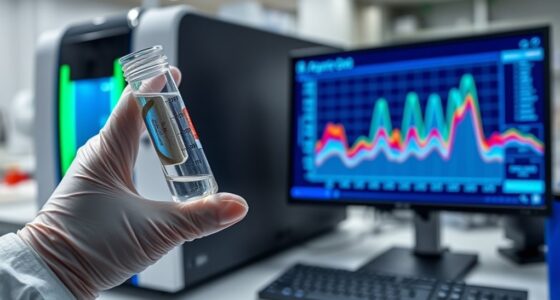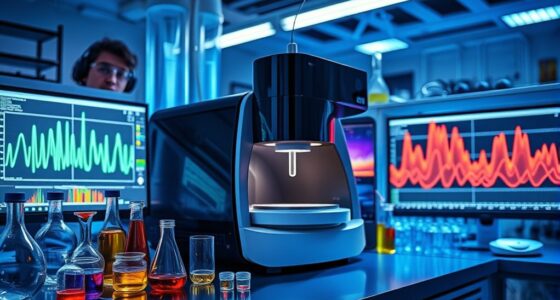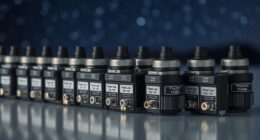Laser-Induced Breakdown Spectroscopy (LIBS) allows you to quickly analyze a material’s elemental composition with a focused laser pulse that creates plasma. This plasma emits light at characteristic wavelengths, revealing the elements present, all in just seconds. Its rapid and non-destructive nature makes it ideal for real-time applications across industries like environmental testing, metallurgy, and space exploration. To discover how to optimize accuracy and maintain calibration, keep exploring further insights.
Key Takeaways
- LIBS uses focused laser pulses to rapidly ablate material and generate plasma that emits characteristic light for elemental detection.
- It provides immediate, real-time elemental analysis without extensive sample preparation.
- Regular spectral calibration ensures accurate interpretation of emission lines and prevents measurement errors.
- Plasma diagnostics optimize laser and environmental parameters, enhancing analysis precision and consistency.
- The technique is widely applicable across industries, offering fast, reliable, and on-the-spot elemental insights.

Laser-Induced Breakdown Spectroscopy, or LIBS, comes with the advantage of being adaptable to different project environments, making it suitable for diverse applications. This technique uses a focused laser pulse to ablate a tiny amount of material from a sample, creating a plasma. As this plasma cools, it emits light at characteristic wavelengths that reveal what elements are present. The process is rapid, often providing results in just a few seconds, making it ideal for real-time analysis across various fields like environmental monitoring, metallurgy, and even planetary exploration.
A key aspect of LIBS is spectral calibration. Before you can accurately interpret the emission spectra, you need to verify your equipment is properly calibrated. This involves comparing the observed spectral lines to known standards, allowing you to correct for any instrumental shifts or distortions. Proper spectral calibration guarantees that the wavelengths you measure correspond precisely to the specific elements in your sample. Without it, your analysis could be off, leading to incorrect conclusions about the material’s composition. Additionally, regular calibration routines help mitigate instrument drift that can occur over time, ensuring sustained accuracy in your measurements.
Spectral calibration ensures accurate element identification by correcting instrument shifts and distortions in LIBS analysis.
Continuous calibration also helps maintain accuracy over time, especially when analyzing different samples or operating in varying environmental conditions. Plasma diagnostics plays an essential role in understanding the LIBS process. When the laser hits the sample, it creates a high-temperature plasma that emits light. By analyzing this plasma’s properties—such as temperature, electron density, and emission intensity—you can optimize the conditions for better spectral clarity and sensitivity.
Plasma diagnostics helps you understand how factors like laser energy, ambient pressure, and sample composition influence the plasma’s behavior. This knowledge allows you to fine-tune the process, ensuring consistent and reliable results. It also helps in identifying potential interferences or spectral overlaps that could obscure the detection of certain elements. In essence, LIBS combines the precision of spectral calibration with insightful plasma diagnostics to deliver rapid and accurate elemental analysis. It’s a powerful tool because it doesn’t require extensive sample preparation—just a quick laser shot and you’re ready to analyze.
Whether you’re inspecting metal alloys, assessing soil contamination, or exploring extraterrestrial landscapes, LIBS provides immediate feedback on what’s in your sample. By understanding and controlling the plasma dynamics and calibration procedures, you can trust that your elemental data is both precise and reliable. Additionally, maintaining optimal instrument calibration is crucial for consistent accuracy across different sessions and environmental conditions. This synergy of techniques makes LIBS an indispensable method for instant, on-the-spot analysis in a wide range of scientific and industrial applications.
Frequently Asked Questions
How Does LIBS Compare to Other Elemental Analysis Techniques?
Compared to other elemental analysis methods, LIBS offers faster detection speed and decent spectral resolution.
You can analyze samples rapidly with minimal preparation, making it ideal for real-time applications.
While techniques like ICP-OES or XRF might provide higher spectral resolution, LIBS excels in speed and versatility, allowing you to perform quick, on-site analysis.
This balance makes LIBS a powerful tool when rapid results are essential.
What Are the Safety Considerations for Using LIBS?
Oh, don’t forget your superhero cape when handling LIBS—safety first! You need to prioritize laser safety by wearing protective goggles and avoiding direct eye exposure.
Handle samples carefully to prevent accidental splashes or dust inhalation. Keep the equipment well-maintained, and guarantee proper ventilation.
Can LIBS Analyze Samples in Harsh Environmental Conditions?
You can rely on LIBS for analyzing samples in harsh environmental conditions because it offers environmental resilience and rugged deployment capabilities. Its design allows it to operate in extreme temperatures, dust, and moisture without compromising performance.
This makes LIBS suitable for field use in challenging environments, ensuring you get instant elemental analysis even in rugged settings. Its robustness enhances productivity and data accuracy in demanding conditions.
What Limitations Affect LIBS Accuracy for Trace Elements?
You should know that LIBS can struggle with trace element detection, with detection limits often reaching parts per million.
Matrix effects considerably impact accuracy because the surrounding sample composition interferes with signal clarity. These effects can cause underestimation or overestimation of trace elements, making precise analysis difficult.
Improving calibration and minimizing matrix effects are essential to enhance LIBS accuracy for detecting these low-concentration elements.
How Portable Are LIBS Systems for Field Applications?
You’ll find that LIBS systems are increasingly portable, thanks to compact designs and lightweight components, making them ideal for field applications.
Their portable design allows for rugged deployment, so you can use them outdoors or in harsh environments without worry.
This mobility enables immediate analysis on-site, saving time and resources, and allowing you to make quick decisions without needing lab access, enhancing your fieldwork efficiency considerably.
Conclusion
Laser-induced breakdown spectroscopy (LIBS) acts as your quick, reliable detective, revealing the elemental secrets of materials in an instant. Just as a lightning strike illuminates the night, LIBS lights up the composition of your sample with precision and speed. This technique’s ability to deliver real-time analysis makes it a game-changer across industries. Embrace LIBS to unearth insights effortlessly, turning complex data into a clear, shining path forward in elemental analysis.









